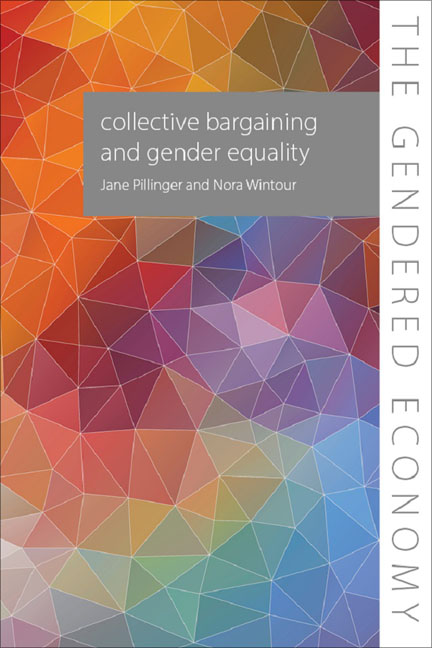Book contents
- Frontmatter
- Dedication
- Contents
- Acknowledgements
- Acronyms
- Foreword
- 1 Introduction
- 2 The gender dimensions of collective bargaining
- 3 Collective bargaining as a tool for gender equality: evidence from across the world
- 4 Changing employment patterns, precarious and informal work, and the challenge for collective bargaining
- 5 The global dimension of collective bargaining: the role of global framework agreements in promoting gender equality
- 6 Conclusion
- References
- Index
2 - The gender dimensions of collective bargaining
Published online by Cambridge University Press: 09 August 2023
- Frontmatter
- Dedication
- Contents
- Acknowledgements
- Acronyms
- Foreword
- 1 Introduction
- 2 The gender dimensions of collective bargaining
- 3 Collective bargaining as a tool for gender equality: evidence from across the world
- 4 Changing employment patterns, precarious and informal work, and the challenge for collective bargaining
- 5 The global dimension of collective bargaining: the role of global framework agreements in promoting gender equality
- 6 Conclusion
- References
- Index
Summary
This chapter reviews the necessary preconditions for collective bargaining to promote gender equality. There is wide agreement that centralized (national or sector-wide) arrangements, strong employers’ and workers’ organizations, participation of women in negotiations, and government support for collective bargaining and equality are among the most important preconditions for gender equality to be progressed through collective bargaining (Dickens 1998; Hayter 2015; Rubery & Koukiadaki 2016). This chapter builds on this perspective by looking at seven interrelated preconditions that underpin gender equality dimensions of collective bargaining. These are set out in Figure 2.1 below. They relate to issues both inside and outside of the workplace.
STRONG SOCIAL DIALOGUE STRUCTURES
Level of bargaining and gender equality outcomes
Overall, collective bargaining on gender equality is more effective when national and sectoral bargaining lead to institutionalized forms of bargaining and wage setting (Hayter & Weinberg 2011; Rubery & Koukiadaki 2016). In a study of 19 countries where sectoral or national bargaining exists, over 75 per cent of wage earners were covered by collective bargaining agreements (CBAs) (Visser, Hayter & Gammarano 2015). In several countries in Europe (Austria, Germany and Belgium) and in South Africa, Brazil and Argentina, national and sectoral CBAs have reduced wage inequalities and contributed to productivity and competitiveness (Hayter 2012).
Gender differences are lower when bargaining is centralized and where there is a framework for equality, including model agreements implemented at the workplace (Heery 2006; Pillinger 2014; Ponzellini Aumayr & Wolf 2010). In countries with high levels of collective bargaining coverage, particularly where the law places obligations on companies to conclude collective agreements, and where there are national or sectoral agreements, less equality and smaller pay gaps are found, compared to countries with low bargaining coverage (Eurofound 2010; Hayter & Weinberg 2011; ILO 2011). In this regard Reegård argues that “coordinated wage bargaining from the centre reduces wage disparity and contributes to a more equal society” (2013: 114). Estimates suggest that with one per cent increase in social dialogue “coverage” the gender pay gap is reduced by 0.16 per cent (European Commission 2009) and the higher the degree of coordination in wage formation, the more equal the distribution of pay (ETUC 2012, 2013a; Tilly 2013).
- Type
- Chapter
- Information
- Collective Bargaining and Gender Equality , pp. 9 - 34Publisher: Agenda PublishingPrint publication year: 2018



